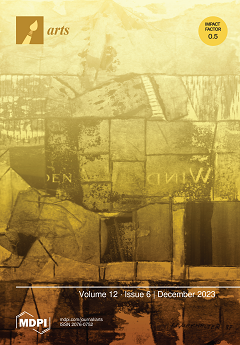The oeuvre of beloved Polish painter Ferdynand Ruszczyc (1870–1936) reflected the patriotic Neo-Romantic landscape trend of the fin-de-siècle prevalent in Germany and the Nordic countries (Denmark, Finland, Norway, Sweden). It should be considered in the context of Nordic visual culture for two reasons:
[...] Read more.
The oeuvre of beloved Polish painter Ferdynand Ruszczyc (1870–1936) reflected the patriotic Neo-Romantic landscape trend of the fin-de-siècle prevalent in Germany and the Nordic countries (Denmark, Finland, Norway, Sweden). It should be considered in the context of Nordic visual culture for two reasons: (1) until the affiliation of Central and Eastern European nations with the Soviet Union in the wake of World War Two, nations bordering the Baltic formed a single, fluid territory of cultural exchange, and (2) Ruszczyc’s oeuvre displays significant commonalities with dominant patriotic and Neo-Romantic trends of progressive artists around the Baltic Sea, where landscape became a vehicle for expressing dreams and emotions, as well as love of homeland. This article situates Ruszczyc’s national and artistic identity at the crossroads of cultures and artistic impulses, regional as well as international. Ruszczyc was born in Bohdanów near Vilnius (now Belarus) to a Polish father and a Danish mother. Like many Polish artists from the Russian partition, he was educated at the Imperial Academy of Fine Arts in St. Petersburg, where he studied with Ivan Shishkin (1832–1898) and Arkhip Kuindzhi (1878–1910). He also travelled to Sweden. Ruszczyc was influenced by the Russian art circle
Mir Iskusstva (World of Art, est. 1898) and is often compared with Nordic (e.g., Akseli Gallen-Kallela; Finnish, 1865–1931) and German (e.g., Otto Modersohn; 1865–1943) artists. His visions of nature are sometimes raw monumental images of the northern landscape or fairy-tale fantasies containing symbolic allusiveness and a mythical, poetic element that evoke intimate memories of the land of his childhood. In his paintings, Ruszczyc presented the changeability of seasons, orchards, soil and streams, clouds formations, and tree trunks with palpable emotion. By exposing the material substance of nature, his paintings also reveal its mystical aspect, its ability to transform in accordance with the cyclical, cosmic rhythm of growth, maturation, death, and rebirth.
Full article




